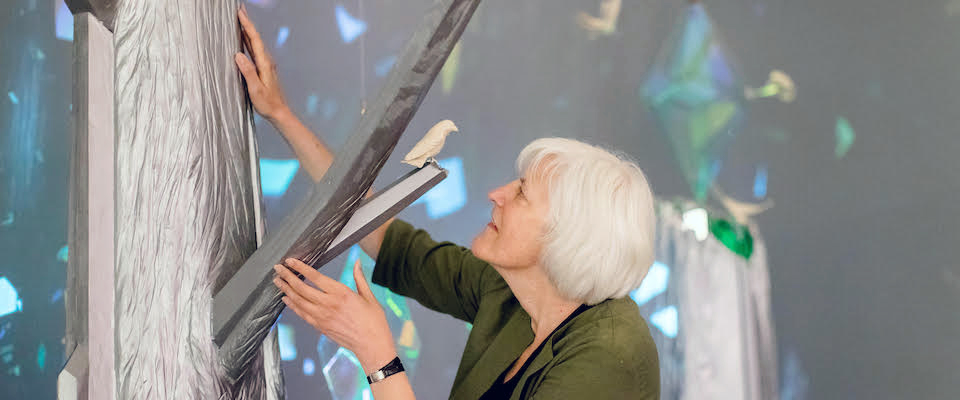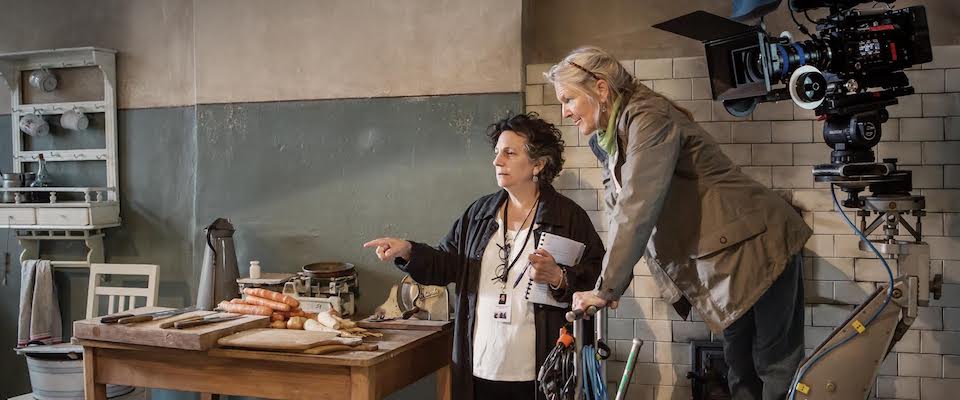On a tour of the Contemporary Jewish Museum’s exhibit Jewish Folktales Retold: The Artist as Maggid, running through January 28, participants passed around a silicone squash representing Michael Arcega’s sculpture The Enchanted Island. The piece is inspired by a story about a shipwrecked rabbi going into a mansion and finding two objects on a table: a cornucopia and a ram’s horn to summon people to prayer. What does he choose? He’s hungry, so it’s the food.

UC Berkeley English professor Georgina Kleege, who was leading the tour, encouraged people to notice the squishiness of the object, how it’s like a water balloon half-filled and how although it might resemble a squash, felt nothing like one. Kleege, who is legally blind, helped formulate what’s called a haptic (related to the sense of touch) encounter, which the museum officials and Kleege believe is the first of its kind. The author of the recently published More than Meets the Eye: What Blindness Brings to Art and a consultant to institutions such as the Metropolitan Museum of Art and the Tate Modern, Kleege has been on many touch tours of museums. She wanted to go beyond that.
Along with the six audio recordings she developed for this exhibit, she worked with the artists who had a sculptural (and therefore touchable) element in their pieces on coming up with models and materials of their art for people to handle. Kleege, the daughter of a painter and a sculptor, grew up going to artists’ studios, galleries, and museums, and she thinks we need to get past the idea that access means just letting disabled people into the museum. Greater inclusion benefits everyone, she says.
“I think what I wanted to do is twist the usual paradigm that the institution is giving access to a disabled person,” she said. “Instead, because I’ve enjoyed this unusual access, I’m creating something which enhances the experience of everybody.” Sighted as well as not sighted people, she stresses, benefit from getting to touch the art. It’s not just the outline of a horse, a person, an arch, but the way the material feels—rough, smooth, heavy, cold, and so on.
Museums are traditionally hands-off places, says the CJM’s Access and Community Engagement Manager Cecile Puretz, who collaborated on this project with Kleege. Like Kleege, she wants to go beyond ramps and ADA compliance.
Kleege wants to dispel the myth that blind people have some super-powered tactile sense not available to sighted people.
“Accessibility doesn’t need to be tacked on,” she said. “We’d like to see it embedded as a creative piece. For example, usually if there’s audio, it’s done by sighted people. To see the blind as producers of cultural knowledge is a radical departure.” It is a way of including everyone and giving access to people we usually don’t think of as going to museums.
The silicon squash wasn’t the only object participants handled. They experienced a model of 200 Year Present, Julia Goodman’s piece with handmade paper and a painted block made out of the same material (Styrofoam) as the arch in Mike Rothfeld’s It is tomorrow we bury here today. Perhaps easier to feel than see was a head made out of the detritus such as string, lace, ribbon, and cardboard used in Elisabeth Higgins O’Connor’s monumental blame/thirst and lullaby/lament, based on stories about the Golem, which is both monstrous and protective.
Kleege, who wants to dispel the myth that blind people have some super-powered tactile sense not available to sighted people, pointed out that we experience things in other ways besides sight and touch. There’s proprioception, for example, the feeling of your body in space. That’s engaged by Rothfeld’s piece, she says.
“[The arch] takes up a lot of space,” she said on the tour. “It’s tall, about nine and a half feet, and blue and shiny. It inhabits this whole corner and acts as an entryway into the whole exhibit. There’s a lot of weightiness, in spite of the lightness of the material.”
Kleege gave careful descriptions of the pieces, such as Laurel Roth Hope and Andy Diaz Hope’s The Woulds, inspired by several folktales in which the characters go into the wood and bad things happen.
“The first thing I wanted to draw your attention to is we’re sort of in a darkened space, not lit like the rest of the gallery. There’s a platform and there’s a configuration of three tree-like structures and a log-like structure on the ground. Gathered around these trees are little tiny birds, some with two heads,” Kleege told the group. “Suspended around the installation are crystals that reflect light. Touching this was extremely tricky—all the surfaces are quite sharp and almost threatening.”
This kind of detail—along with getting to handle objects made from the materials used in the pieces—really helped with her experience, said Sile O’Modhrain, a blind professor of Performing Arts Technology from the University of Michigan, who was on the tour.
“Georgia has such a strong aesthetic sense herself,” she said. “With the one with the birds and the trees and her talking about the jagged edge of the platform, that really changed my perception. And with the representations of the objects made of the raw material, it’s really an aesthetic experience.”
Kleege hopes other institutions will be inspired by what San Francisco’s CJM is doing. “In my most generous imagination, I love the idea of museums hiring blind docents who touch the art and tell you what they’re experiencing,” she said.






















